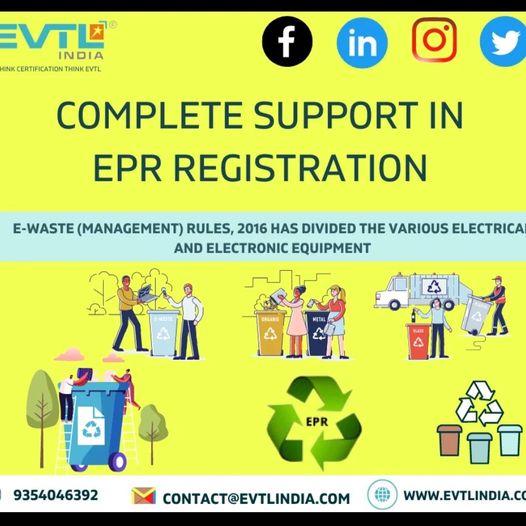Extended Producer Responsibility (EPR) is the idea that a product’s producer is responsible for its post-consumer or end-of-life (EOL) stage beyond traditional sales. This indicates that the producer is accountable for the safe recycling or disposal of the recycled goods or packaging material.
Why is EPR necessary?
The goal of EPR is to get manufacturers to start thinking about how to process their products at their end of life as soon as they design them. As a result, products that are durable and simple to recycle are created. The producer should bear the significant costs of collecting and recycling these wastes, rather than passing them on to the government or the environment.
Currently, the informal sector in India manages over 90% of all electronic waste without safety measures or scientific recycling methods.
Millions of multi-layered plastics (MLP), which are basically all of our biscuit and chip packets, are either burned or dumped into our oceans and landfills, putting animals and plants at risk of serious health problems.
In order to combat this, certain EPR policies in India, as outlined below, require manufacturers of such materials to establish collection and recycling systems.
India’s policies on EPR:
India currently has EPR policies for plastic packaging waste and electronic waste.
The E-Waste (Management & Handling) Rules of 2011 were India’s first introduction to the EPR concept. Reverse logistics for the collection of electronic waste and its distribution to authorized recyclers licensed by the State Pollution Control Board were the responsibility of all manufacturers of electronics, including phones, computers, and washing machines.
The Ministry of Environment, Forestry, and Climate Change issued the new E-Waste (Management) Rules 2016 in March 2016, announcing an update to the E-Waste policy. The new regulations simplify the application process for EPR Authorization and establish stringent targets for producers to collect and recycle EOL products, starting at 30% in the first two years and increasing to 70% by the seventh year.
In addition, the country’s 2016 Plastic Waste Management Rules prohibit the production of non-recyclable plastics and enforce EPR for plastic producers.
Policies for EPR in other parts of the world EPR is a popular idea in Western nations for various materials streams. The EU, Canada, and Germany all have EPR for packaging materials. In a similar vein, EPR for paints in British Columbia and EPR for automobiles in Germany and the Netherlands have been in place for a few years.
The framework of a circular economy and its worldwide implementation has been promoted by organizations like the Ellen MacArthur Foundation, which is based in the United States.
The foundation is demonstrating the seriousness of moving in the direction of building a circular economy, which is at the heart of the concept of Plastic EPR, by publishing research documents that outline economic benefits, collaborating with businesses like H&M to design circular solutions, and running a $2 million innovation prize to keep plastics out of the ocean.
Industry Response over 150 electronic producers have applied for EPR Authorization as a result of the excellent work done by the Central Pollution Control Board, and approximately 85 of them have received the authorization certificate. However, the electronics industry is still hesitant to accept the policy, claiming that the goals are too lofty and unrealistic given the situation in India.
A system for collecting and distributing their post-consumer packaging products has not yet been implemented by the plastics industry, particularly the multilayered plastic (MLP) industry.
Multi-layered plastics, also known as MLP, are constructed by layering a variety of plastics with non-plastics like aluminum foil. These are currently contaminating our soil and water bodies and cannot be recycled.
Proof of Concept Although putting EPR into practice presents a number of difficulties, there are also proactive manufacturers like Tetra Pak that have been voluntarily collecting and recycling their packaging waste from all over the country through channel partners for more than eight years.
In order to expand the market for Tetra Pak recycling, they collaborate with a wide range of stakeholders across the nation, including recyclers and collection agencies.
The Tetra Pak carton is recycled into roofing sheets, chipboard, and stationery items, among other things.
Obstacles to EPR Implementation The separation of waste at its source will be essential for EPR products’ resource recovery. In order to raise public awareness of the importance of recycling and source segregation, producer companies will need to make a significant contribution.
E-waste and plastic waste are widely distributed throughout the nation. Due to the potential for setting up a collection network to be extremely complicated and costly, there are no formalized reverse logistics companies.
Around 90% of these waste streams are handled by the informal sector. It will be challenging to transform them into formal means of responsible waste management while simultaneously ensuring their compliance.
Road Ahead EPR policies should effectively facilitate collaborations between various stakeholders, including the central and state governments, producers, consumers, and the informal sector, in order to effectively reduce the impact of these waste materials on climate change and pollution. The sacred 3R principle (Reduce, Reuse, and Recycle) will be effectively implemented by stringent EPR policies, facilitating a circular economy.
The informal sector’s inclusion would be crucial to the successful implementation of these policies. This will have a significant impact on improving the Base of the Pyramid Population’s standard of living and providing trustworthy employment opportunities in the waste management sector.
The producers now have to take the necessary actions to address this growing issue. To ensure that a significant quantity of their expired products are recovered through this reverse logistics network, producers must make significant contributions and collaborate with specialist collection partners.


